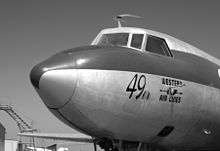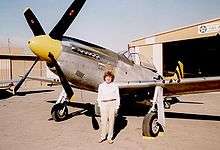Planes of Fame Air Museum
 A flyable P-51 Mustang hangared. | |
| Established | 1957 |
|---|---|
| Location |
Chino, California, and Valle, Arizona. |
| Type | Aviation museum |
| Collection size | 150+ planes |
| President | Steve Hinton |
| Website | www.planesoffame.org |

Planes of Fame Air Museum is an aviation museum located in Chino, California,[1][2][3] and Valle, Arizona.[4] The museum has many flying and static aircraft, along with multiple rare examples under restoration.
History
Planes of Fame Air Museum was founded by Edward T. Maloney on January 12, 1957 in Claremont, California, to save historically important aircraft.[3] At that time, it was called "The Air Museum". A small group of volunteers, including future Museum president Steve Hinton, set out to make the museum's aircraft flyable.
As the Museum's collection of aircraft and memorabilia continued to grow, it became necessary to find a new home with enough space to house everything. In 1962 the museum relocated to nearby Ontario Airport, Ontario, California.[5]
A few years later, in 1970, redevelopment of the airport at Ontario forced The Air Museum to move again. The non-flyable aircraft became part of the "Movie World: Cars of the Stars and Planes of Fame Museum" in Buena Park, California, located near Knott's Berry Farm, while the flyable aircraft relocated to Chino Airport, about 30 miles (48 km) away.[5] When Movie World closed, the name "Planes of Fame" stayed.
Planes of Fame consolidated in 1973, with its static aircraft joining the flying examples at historic Chino Airport in Chino, California.[5] This was fitting as the airport was formerly the home of Cal-Aero Academy, which was an Army Air Corp flight training facility. The academy trained more than 10,000 pilots prior to the end of World War II, making it a perfect location in which to restore and give new life to the aircraft these men had flown into combat more than three decades earlier. As more and more aircraft were restored and the collection grew, an additional display facility was opened in 1995 at Valle, Arizona. Located halfway between Williams, Arizona and the south rim of the Grand Canyon, it houses more than 40 of the Museum’s aircraft, many of which are also flyable.
Growth continued at Chino, too, and in 2002 the Enterprise Hangar was opened. Designed to resemble the hangar deck of a World War II Navy aircraft carrier, it contains a number of items from the USS Enterprise (CV-6), donated by members of her crew and flight squadrons. It also houses many aircraft typical of those that served on the Enterprise during the war.
The Chino Facility underwent further expansion in 2004-2008, with the construction of two new hangars, new offices, a gift shop, library and the Hands-On Aviation youth education center. Display areas for jets and other aircraft of the Korean War, Cold War, and Vietnam War were also added. In October 2009 another new hangar was dedicated. It was built by the famous 475th Fighter Group to store their memorabilia, as well as house the Museum’s rare Lockheed P-38 Lightning.[6]
Collection


The museum's collection of Japanese aircraft is the largest of its type in the world. This collection includes the only flying Japanese Mitsubishi A6M Zero fighter[2] with its original Sakae engine and an Aichi D3A featured in the movie Tora! Tora! Tora!.
Many other rare aircraft are maintained in flyable condition,[3] such as a North American P-51A Mustang, the only Northrop N9MB Flying Wing, a Boeing P-26A Peashooter, a Lockheed P-38J Lightning, and a Republic P-47G Thunderbolt.
Many of the museum's approximately 150 aircraft were built in Southern California, and about 30 are flyable.[7][8] Others are under restoration in the full-time restoration facility. They include:[9]
- North American L-17A Navion
- B-17G, Piccadilly Lilly II
- Bell P-59A Airacomet[4]
- Spanish-built Bf 109 (a Hispano Aviación HA-1112 “Buchon”)
- North American O-47
- Aichi D3A2 "Val"
- Grumman OV-1 Mohawk
Monthly flights and annual airshows

The museum holds a monthly mini-airshow around a certain theme,[1] such as: "World War I Aviation", "Experimental Aircraft", "Korean War Aviation", "Airplanes In The Movies" and "Naval Aviation". Each mini-airshow starts with one or more talks or seminars given by people involved with the featured aircraft (such as combat pilots), followed by a flight demonstration of two or three aircraft related to that day's theme.[10]
The museum flies all of its airworthy aircraft, as well as many other warbirds visiting from other museums or brought by private owners, during its annual airshow. This event is the largest gathering of warbirds in the western US. Many aircraft are rare or one of a kind.[11]
Military vehicles
The Military Vehicle Corps, often referred to as the Motor Pool, is a small group within the Planes of Fame Air Museum. The Military Vehicles in their collection[4] are primarily from World War II and are maintained and operated by a group of Museum volunteers. These vehicles are used in parades, public events (e.g. Marching Thru History), and WWII re-enactments. The following vehicles are some of those that are on display at Planes of Fame Air Museum in Chino, CA.[12]
475th Fighter Group
Members of the 475th Fighter Group (Satan's Angels) have established a permanent home for the artifacts, photographs, records and memories of the U.S. Army Air Forces unit that accounted for the 562 victories, two Presidential Unit Citations, and produced 42 "Aces" in the South Pacific combat area. It was unique in that it was the first all Lockheed P-38 group and was formed overseas in Australia.
This new museum, legally known as The 475th Fighter Group Historical Foundation, Inc., was housed in a modern steel building reminiscent of those used by the Armed Forces during World War II. It was dedicated on October, 1997, at the expanding March Field Museum complex located at the former March Air Force Base near Riverside, California where the first test fight of the P-38 took place. The March Field Museum chronicles the history of U.S. military aviation from World War I in 1917 to the present.
Over the past nineteen years, many people have donated time, skills and memorabilia in order to preserve the history and proud heritage of the many valiant men of the 475th and these efforts have culminated in a 1,250-square-foot (116 m2) building.
In 2005 the decision was made to move the museum and become part of The Air Museum Planes of Fame. A new 3,600 sq ft (330 m2) hangar at Planes of Fame is under construction for the 475th.[13][14]
See also
- Yanks Air Museum, another air museum located at the Chino Airport.[15]
- List of aerospace museums
References
- 1 2 Flight Journal, Aces of the Red Star at Planes of Fame Air Museum, Aviation in the Movies, February 2, 2008 - Chino, California, Retrieved March 5, 2011.
- 1 2 World War II Museums, Planes of Fame Air Museum, Retrieved March 5, 2011.
- 1 2 3 Exploring The Air Museum - Planes of Fame Chino, Warbird Alley, California, Retrieved March 5, 2011.
- 1 2 3 Planes of Fame Air Museum, AviationMuseum.eu, Retrieved March 5, 2011.
- 1 2 3 Mormillo 1983, p. 58.
- ↑ "History & Mission". Planes Of Fame. 1957-01-12. Retrieved 2013-07-15.
- ↑ Ogden, Bob. Aviation Museums and Collections of North America, Sudbourne, England, 2007. ISBN 978-0851303857.
- ↑ Parker, Dana T. Building Victory: Aircraft Manufacturing in the Los Angeles Area in World War II, Cypress, CA, 2013. ISBN 978-0-9897906-0-4.
- ↑ "Restoration Projects". Planes Of Fame. 1942-10-01. Retrieved 2013-07-15.
- ↑ "Events Calendar". Planes Of Fame. Retrieved 2013-07-15.
- ↑ "Air Show 2013 Recap". Planes Of Fame. Retrieved 2013-07-15.
- ↑ "Military Vehicles". Planes Of Fame. Retrieved 2013-07-15.
- ↑ "475th Fighter Group Historical Foundation". 475th.org. Retrieved 2013-07-15.
- ↑ "475th Fighter Group". Planes Of Fame. Retrieved 2013-07-15.
- ↑ "Yanks". yanksair.com. Retrieved 2016-09-21.
- Mormillo, Frank B. "Chino's "Planes of Fame"". Air Enthusiast. Twenty-three, December 1983–March 1984. Bromley, UK: Fine Scroll. ISSN 0143-5450. pp. 56–64.
External links
| Wikimedia Commons has media related to Planes of Fame Air Museum. |
- Planes of Fame Official Site
- Racing Planes of Fame: A visit to the Planes of Fame Air Museum
- Pacific Wrecks Database listing
- YouTube video of Planes of Fame Air Museum
Coordinates: 33°58′53″N 117°38′23″W / 33.98139°N 117.63972°W